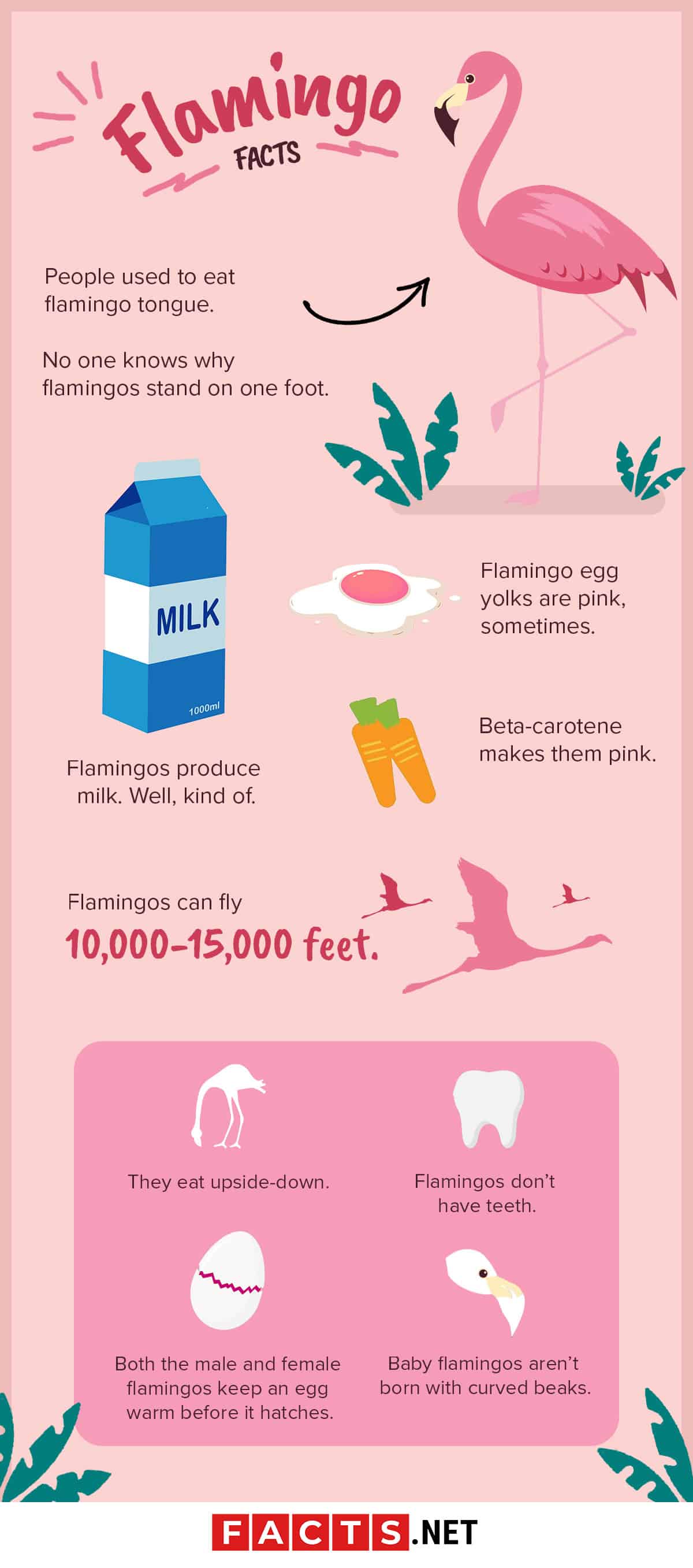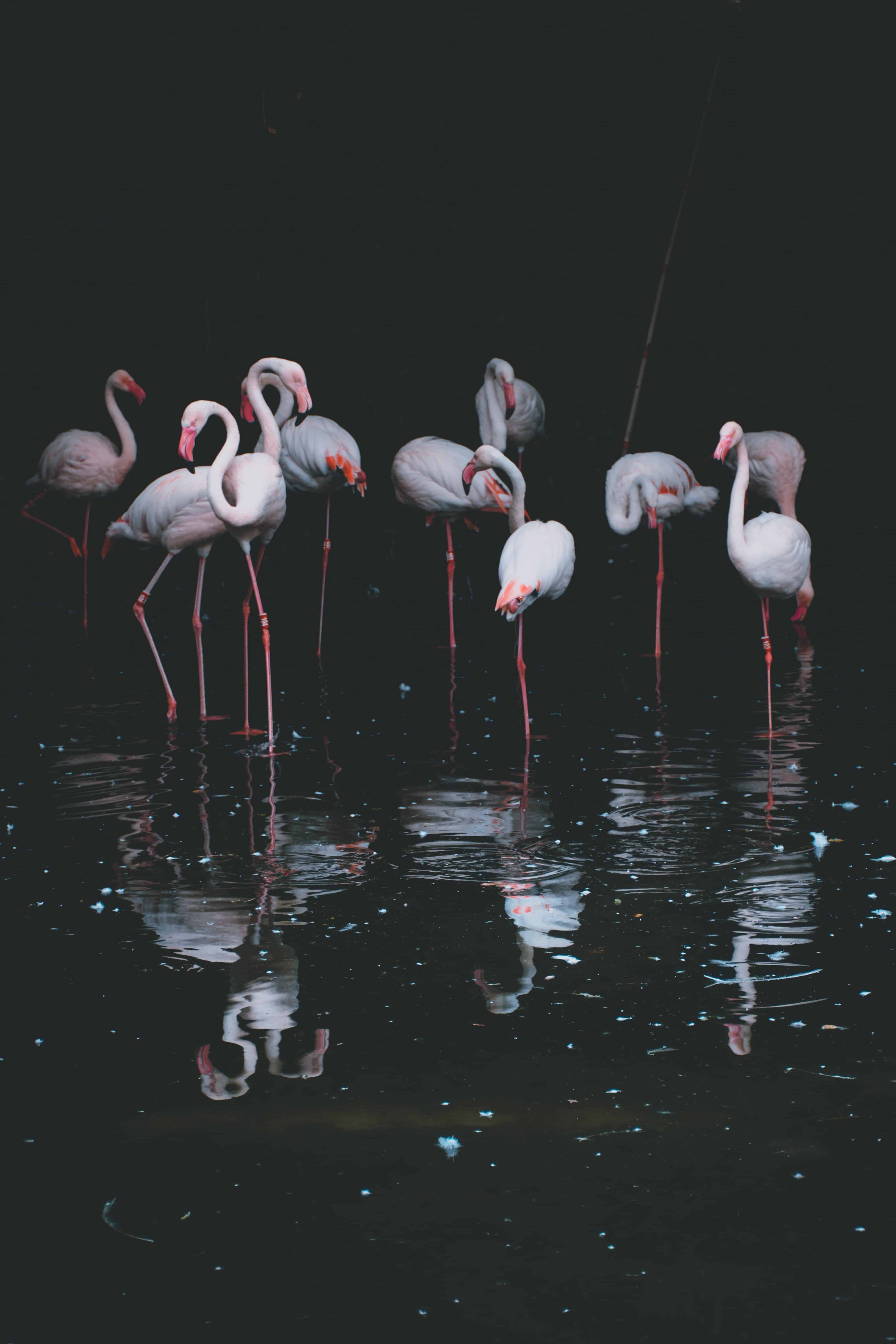
Flamingos are one of the most exotic-looking birds in the animal kingdom. Their distinct look and peculiar motions established these creatures in pop culture. Find the answers to an animal that brings so many questions with these weird and interesting flamingo facts.
- Flamingos are usually found in swamps and mudflats.
- There are six known species of Phoenicopteridae: the greater flamingo, lesser flamingo, James’s flamingo, Chilean flamingo, Andean flamingo, and American flamingo.
- Fully-grown flamingos stand at 4 ft to 5 ft tall.
- A flamingo typically weighs 4 to 8 pounds – that’s only around 1 kg to 3 kg.
- They are not endangered. Flamingos are classified under “least concern.”
- Their name comes from the Portuguese or Spanish term flamengo, which means “flame-colored.”
- Flamingos live between 20 and 30 years.
- Flamingos are classified as waders: a family of long-legged birds found on bodies of water.
- There are 4 species of flamingo native to America, while 2 species are native to Asia, Europe, and Africa.
- A group of flamingos is called a colony.
- They are non-migratory: a colony would only leave an area if the climate or lack of food calls for it.
- Their wingspan ranges from 95-100 cm (lesser flamingo) to 140-165 cm (greater flamingo). For the Caribbean flamingo, it is 150 cm.
- Baby flamingos are called chicks.
- They are the national bird of the Bahamas.
- The greater flamingo is the tallest species (~5 ft), while the lesser flamingo is the smallest (~3 ft).
- Flamingos don’t breathe while eating.
- The oldest flamingo recorded lived up to 83 years old.
- Flamingos spend 15% to 30% of a day grooming: their special gland produces oil that they spread over their feathers.
- Flamingo chicks are born gray – their diet makes them pink later on.
- The “knees” you see on a flamingo is actually their ankle joints. Their actual knee joint is further up their body and hidden by its feathers.
Flamingo Facts Infographics

People used to eat flamingo tongue.
The people of Ancient Rome were known to eat their tongues as a delicacy.
Flamingos produce milk. Well, kind of.
No, they don’t have mammary glands – but flamingos can produce a certain “milk” from their upper digestive tracts. Both male and female flamingos produce crop milk to feed their chicks. This concoction contains protein, fat, and red and white blood cells.
No one knows why flamingos stand on one foot.
Flamingos usually pose with one foot tucked under their bodies. A theory suggests that they do it to conserve body heat in the cold water of their feeding areas, but it has not been confirmed. Astonishingly, a study showed that this behavior does not cause muscle strain in their legs, which means they can do it without physical effort.

Beta-carotene makes them pink.
Flamingo diet largely consists of crustaceans and algae, which are rich in carotenoids. This pigment gives flamingos the hot pink or reddish coloration they are known for.
They eat upside-down.
The flamingos’ curved bill is specially designed to filter food from mud and water. Flamingos feed by combing through the mud with their feet and catching it in their beaks while their heads are upside-down.
Flamingos don’t have teeth.
Flamingo beaks and tongues are lined with lamellae, a hair-like structure that filters out mud and silt from their food.
Flamingos can fly 10,000-15,000 feet.
Flamingos’ proportions and light body density allows them to fly at a speed of 50-60 kph and distances up to 600 km.

Flamingo egg yolks are pink, sometimes.
Contrary to what you might think, flamingo eggs are similar to chickens eggs: white on the outside and yellowish or reddish on the inside. In some cases, however, flamingo egg yolks may have a pinkish hue.
Both the male and female flamingos keep an egg warm before it hatches.
Although it’s observed in most birds that only the mother sits on the egg, flamingo parenting is equal for both roles. The parents’ sole responsibility is feeding the chicks with milk crop until they can hunt for prey with their peers.
Baby flamingos aren’t born with curved beaks.
Their beaks become curved after a few months.
Was this page helpful?
Our commitment to delivering trustworthy and engaging content is at the heart of what we do. Each fact on our site is contributed by real users like you, bringing a wealth of diverse insights and information. To ensure the highest standards of accuracy and reliability, our dedicated editors meticulously review each submission. This process guarantees that the facts we share are not only fascinating but also credible. Trust in our commitment to quality and authenticity as you explore and learn with us.
